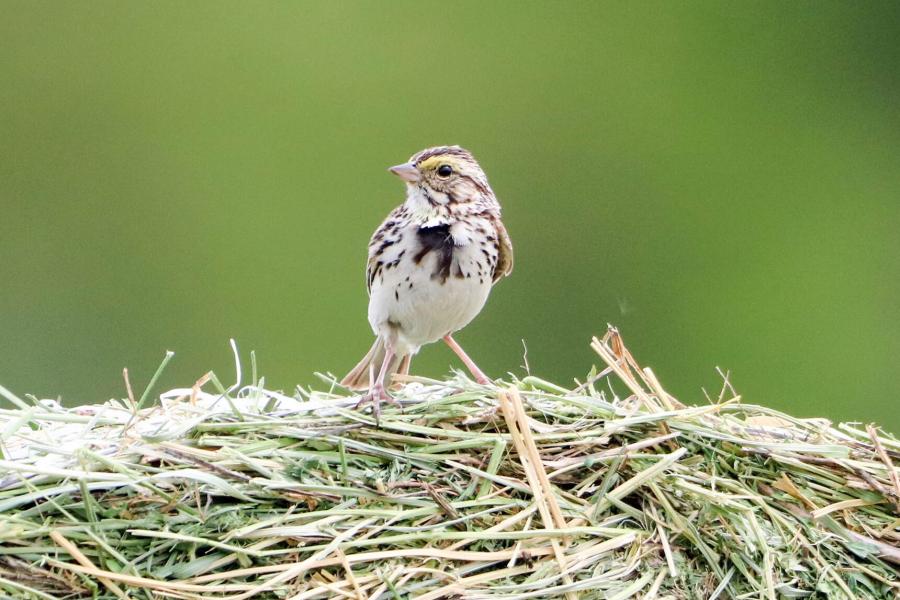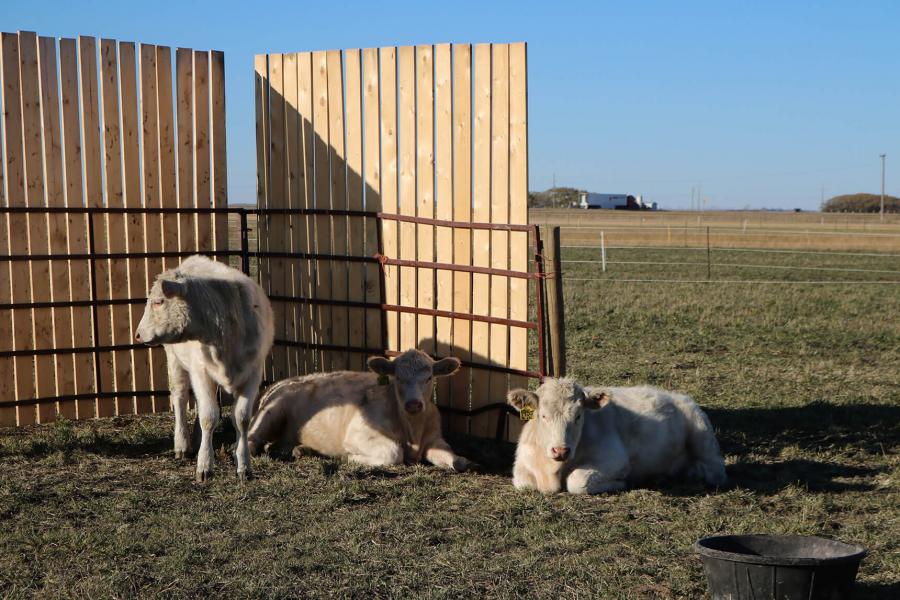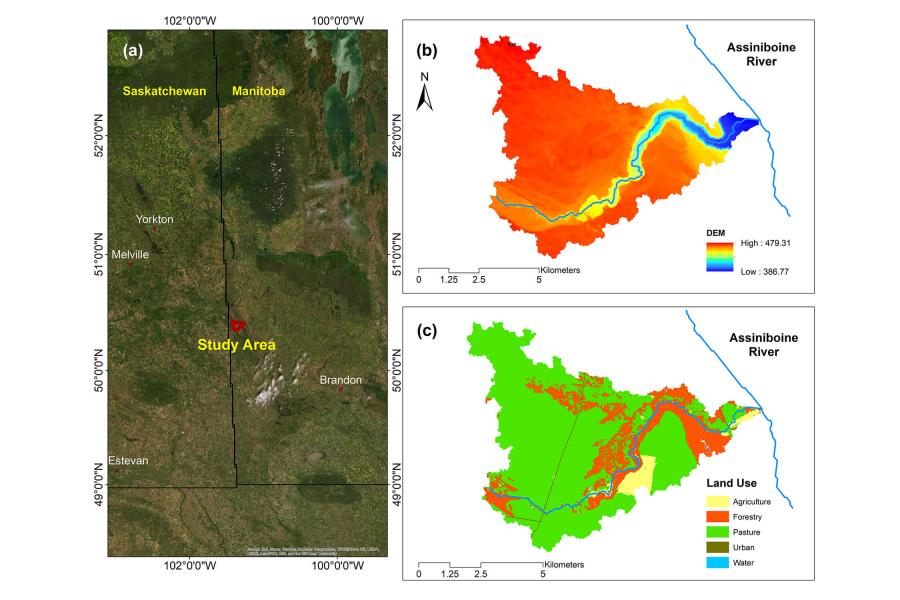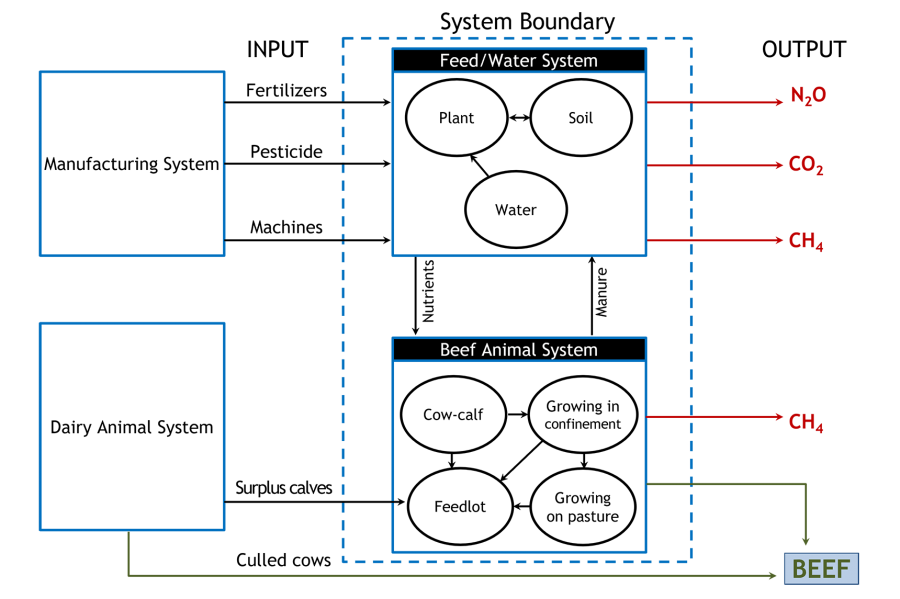Leveraging data to improve food systems
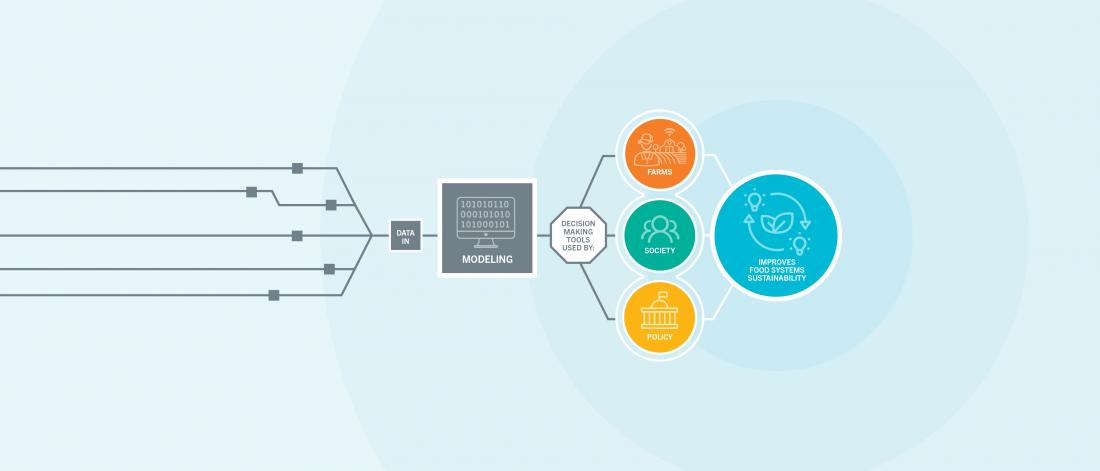
Using data as a decision-making tool
Technology has made it possible to collect infinite amounts of data on a continuous, real-time basis. To make the most of these capabilities, NCLE researchers are developing models and simulations that make it easier to interpret data and put it to work for better on-farm decisions and policy development. This work supports a deeper understanding of how farming practices and climate changes affect sustainability – from a system-wide perspective right down to specific commodities, landscapes and farm types.
Through validation research, data modellers also test the reliability of research findings and data-driven tools. In this way, stakeholders are able to leverage more value from research investments – past, present and future.
Data and modelling research areas
- Life-cycle analysis of environmental impacts
- Life-cycle assessments of mitigation strategies
- Modelling to predict impact of changing conditions and practices
- Modelling to determine landscape impact at different production scales
- Modelling to develop livestock-centred waste reduction strategies for the collective food production system
- Smarter farm and barn management using digital tools for precision livestock farming
Asking the big questions, seeing the big picture
Shedding new light on how beef cattle influence watershed nutrient dynamics
Researchers have amassed extensive data about watersheds across Canada, from soil type and microtopography to flora and fauna. But until recently, watershed data hadn’t been integrated with research findings about beef cattle operations – at least not in a comprehensive, scalable way.
Imagine how valuable all of this data would be if combined into reliable, science-backed models that could show the regional influence of cattle on watersheds in different situations. Our understanding of the complex interactions between cattle, soil, water and nutrients would be elevated to a whole new level.
Read more
This is the challenge Marcos Cordeiro is tackling as he develops new models aimed at improving stewardship within the prairie region. His research project, co-led by soil scientist David Lobb, is an example of how the power of data is being embraced by researchers associated with the National Centre for Livestock at the Environment at the University of Manitoba.
As an assistant professor in sustainable food systems modelling, Cordeiro is excited about the potential to use this new systems-based approach to better understand how beef cattle interact with the landscape.
Rather than looking at particular parts of an ecosystem in isolation, their project includes all factors affecting the movement and fate of nutrients as they are consumed and released at a regional level.
“That’s important because reducing the impact in one part of a system can sometimes result in unintended consequences elsewhere. And also, by considering all sources of nutrients and their movement, we can measure the net effect of beef cattle in an area by quantifying the relative contribution of different nutrient sources.”
Cordeiro is developing models to track export of nitrogen and phosphorus from three watersheds across the Canadian Prairies, including how much manure is deposited by cattle and how each of these nutrients move from pastures to waterways. Also factored in are the nutrients contributed by other sources, such as decaying plants and soil, and the many features affecting how water moves through an area, including the type of land cover, soil and topography.
In this way, the models can determine where nutrients will be exported by moving water, and in what quantities. They can also predict how well nutrients will eventually be recycled back to plants, and from plants to animals.
Another goal of the work is to fill gaps in knowledge about how to manage grasslands under changing weather conditions, Cordeiro says.
“We’re using 15 years of productivity data from Manitoba, Saskatchewan and Alberta, gathered in wet years and dry years, and 15 years of weather data,” Cordeiro says. “By bringing this data together, we can provide valuable risk management information to beef producers throughout the Prairies.”
By running different scenarios through these models, researchers can then determine how nutrient dynamics and pasture quality are likely to change with different management practices, herd sizes and weather. In this way, the models can provide a big-picture look at the effects at the farm level as well as the larger landscape.
Cordeiro says this type of modelling would not have been possible a few years ago, but recent advances in data availability and computing capacity have been game-changers. Huge amounts of data can now be fed into software, and large-scale simulations of different scenarios can be run within a reasonable time and cost. Beyond the farm, Cordeiro sees plenty of opportunity to apply these techniques to all forms of land use, and on a much larger scale.
"The ultimate goal is to model the entire Prairie region so we can look at the combined effect of climate, physiography and land management, right down to the specific commodities that make the most sense in different areas. This really fits into the big picture of improving stewardship throughout the agriculture sector."
Research team
Scientists:
Marcos Cordeiro (PI), Animal Science, University of Manitoba
David Lobb (Co-PI), Soil Science, University of Manitoba
Kim Ominski, Animal Science, University of Manitoba
Don Flaten, Soil Science, University of Manitoba
Tim McAllister, Agriculture and Agri-Food Canada - Lethbridge
Henry Wilson, Agriculture and Agri-Food Canada - Brandon
John Pomeroy, University of Saskatchewan
Helen Baulch, University of Saskatchewan
Merrin Macrae, University of Waterloo
Postdoctoral fellows:
Isaac Aboagye
Kang Liang
Graduate students:
Bryan Encabo (MSc student)
Baiyan Zhou (MSc student)
Funders and partners
- University of Manitoba
- Beef Cattle Research Council
- Manitoba Beef Producers
- Mitacs
- NSERC
- Canada Foundation for Innovation
Beefing up our understanding of biodiversity
Imagine trying to count and map a thousand different species of mammals, birds and plants, lichens, mosses and soil mites, and using this information to explore the benefits and impacts of the beef industry.
It might seem impractical, if not impossible. But now this quantitative snapshot of land use practices and biodiversity has been produced through a collaboration of the Alberta Biodiversity Monitoring Institute (ABMI), the National Centre for Livestock and the Environment (NCLE) and Agriculture and Agri-Food Canada (AAFC).
Read More
By combining ABMI's rich data set and modelling expertise with the detailed knowledge of cattle production systems possessed by NCLE and AAFC, they've created a new tool for understanding the impacts and relationships.
"We are proud to be part of the first and only team in Canada examining biodiversity associated with cattle production systems at this scale," says NCLE director and animal science professor Kim Ominski.
"A richness of species is the mark of a healthy agroecosystem, and cattle producers retain the open spaces that make that richness possible. Studies like this help us understand how cattle producers can operate those levers, so they can maximize benefits while mitigating any potential harm."
Part of an international effort
The NCLE researchers involved in this benchmarking project are part of a team of scientists and cattle sector partners helping to map the biodiversity footprint of beef production in Alberta, with the intent to continue these efforts across Canada. This project is linked to an international effort led by the Livestock Environmental Assessment and Performance Partnership (LEAP) of the Food and Agriculture Organization (FAO) of the United Nations.
Canada's representative, AAFC researcher Tim McAllister, is the current chair of the LEAP steering committee and has also served as the LEAP Biodiversity Technical Advisory Group Leader. McAllister encourages researchers all over the world to use LEAP assessment methods, which are also the foundation of the approaches used by the Canadian Roundtable for Sustainable Beef. In this way, LEAP is bringing a consistent approach to the measurement and study of biodiversity in livestock production systems everywhere.
McAllister says it's an important step for the study of biodiversity, which until recently had no single common unit of measurement.
"Biodiversity is intrinsically complex – and perhaps this is why it's left out of many environmental assessments of the livestock sector," he explains. "Now, thanks to this international effort, we have a life cycle assessment model that gives us common measures and language for understanding the biodiversity impact of livestock production in different contexts. We can express the biodiversity impact per tonne of protein produced."
Leveraging data to find the answers
The mammoth task of mapping cattle production impact on biodiversity is made possible by the use of comprehensive datasets and advanced computer modelling. When combined, researchers can determine the biodiversity impact of different types of livestock operations in specific contexts.
For assessments here in the Prairies, the starting point is the vast biodiversity and habitat dataset collected by the ABMI. The institute has counted and recorded more than 1,000 species, from mammals to lichens, at over 500 sites extending across beef-producing regions in Alberta.
At each of these sites, ABMI has recorded the abundance of each species, as well as local habitat characteristics such as soil, climate, and land use variables.
"This is a unique opportunity to link what is one of the world’s most comprehensive databases on biodiversity and habitats with detailed information on Alberta’s beef production practices," says Majid Iravani, applied research scientist at ABMI. "With this data, we've been able to quantify the impacts of the entire beef sector on biodiversity in a consistent way across Alberta and determine how different beef production stages and systems lead to loss and gain in animal and plant biodiversity."
Researchers then overlaid regional land use data showing where different types of beef cattle operations are located, and the land use types supporting these operations.
When the two datasets are run through biodiversity models, researchers can determine how individual species and biodiversity as a whole are impacted by different types of cattle operations – from cow-calf systems on range through to large commercial feedlots.
"The collaboration and the synergy behind this project are a great example of what NCLE is all about," says Ominski. "We're combining data and expertise across a range of disciplines, and then producing outcomes that are more than the sum of their parts."
"The ultimate goal is to add the biodiversity findings to a larger life cycle analysis, combined with measurements of greenhouse gases, nutrient movement, carbon sequestration and water quality. Approaches developed in Alberta will then be applied across the country," adds Mohommad Reza Marami Milani, the postdoctoral fellow working on this project.
"NCLE researchers and partners have been studying all of these sustainability factors, and now we have one more area of knowledge to bring to the table," Ominski says.
Among those at the table are producers who want to make their operations more sustainable, efficient and trusted by the public, she says.
"As cattle producers turn inedible forms of plant life into highly nutritious food, they can also support biodiversity. In this way they can help regulate our air, water quality and climate, while preserving the rich biodiversity in native grasslands, one of Canada's most threatened ecosystems. This kind of data modelling shows us how."
Research team
Scientists:
Tim McAllister (PI), AAFC Lethbridge
Kim Ominski and Marcos Cordeiro, Animal Science, University of Manitoba
Majid Iravani, Alberta Biodiversity Monitoring Institute, University of Alberta
Sarah Pogue, Agriculture and Agri-Food Canada Lethbridge
Postdoctoral fellow:
Mohammad Reza Marami Milani (University of Manitoba)
Funders and partners
- Beef Cattle Research Council, Canadian Cattlemen's Association
- Mitacs
- Alberta Biodiversity Monitoring Institute
Meaningful data builds trust, understanding and awareness
When a group of researchers set out to benchmark the environmental impact of Canadian beef, they never dreamed their findings would appear in a national ad campaign for one of the nation's biggest restaurant chains.
But that's what happened in 2018, after the National Centre for Livestock and the Environment, (NCLE), along with colleagues from Agriculture and Agri-Food Canada, published the first science-based studies in Canada to calculate the environmental footprint of cattle on a national scale. The analyses provided researchers, consumers and food companies with a reliable, big-picture view of how Canada’s beef sector interacts with soil, water and air – and the response showed just how hungry Canadians are for facts they can trust and share.
Read more
"After our papers were published in 2016 and 2018, the interest was incredible," recalls Kim Ominski, director of NCLE. "Producers, in particular, wanted to know how they could get their hands on this information."
Among those looking for credible facts was the nation’s biggest burger chain. McDonald’s Canada quickly recognized that the study’s findings could add extra meat to its marketing campaign for the new Mighty Angus, a burger containing 30% or more beef from sources certified by the Canadian Roundtable for Sustainable Beef. Soon ads featuring facts from the study were running during broadcasts of the Stanley Cup and NBA playoffs, in movie theatres, on billboards and in print.
"The beef sector could never have achieved this kind of awareness on its own," says Ominski. "It happened because our published results provided access to reliable facts about beef's impact on the environment. It shows the power of data when it’s modelled and shared in meaningful ways."
When the environmental impact study began, the team had a less lofty but equally important objective in mind. Their goal was to set clear benchmarks to better understand management practices and identify opportunities to improve the impacts of Canada’s beef sector on our soil, water and air.
"To measure progress, you need to know where you’ve come from and where you are right now," Ominski sums up.
The team's first step was to conduct a survey of 1,009 beef producers across Canada – the first big national survey of its kind. This work generated an inventory of how beef operations are managed in different geographic areas, operating within different constraints, landscapes, water and nutrient cycles, plant and soil types and a myriad of other factors.
"We published the survey results in the Canadian Journal of Animal Science, and within a few months it attracted tremendous interest," Ominski recalls.
Using this and other information, the team was then able to estimate greenhouse gas and ammonia emissions, as well as water use efficiency.
When the final numbers were crunched, it was exciting to see the results. The model showed that Canadian ranchers use 17% less water and create 15% fewer greenhouse gases to produce a pound of beef than 30 years earlier. They also use 24% less land to produce the same amount of beef.
"This research has served as the cornerstone for much of our subsequent work examining the environmental impact of the cattle industry including biodiversity and food waste."
Ominski says the other benefit for beef producers and food companies is how it has empowered them to respond to questions about the role of cattle in ecosystem management. That's an important advantage at a time of growing curiosity about how food is produced and an excess of misinformation.
"Producers are under a lot of pressures and stresses that weren’t there before. Now they have a way to point to the science when these discussions arise."
NCLE is currently doing the same kind of study with the pork sector, using a similar methodology.
Research team
Scientists:
Getahun Legesse (lead author), Manitoba Agriculture and Rural Development
Tim McAllister (project lead), AAFC, Lethbridge
Kim Ominski (greenhouse gases, primary supervision), University of Manitoba
Emma McGeough (greenhouse gases), University of Manitoba
Marcos Cordiero (water), University of Manitoba
Graduate students:
Aklilu Wake (modelling), AAFC, Swift Current former PhD student
Funders and partners
- Beef Cattle Research Council
- Agriculture and Agri-Food Canada
Resources
Scientific publications
- Effect of changes in management practices and animal performance on ammonia emissions from Canadian beef production in 1981 as compared with 2011
- Greenhouse gas emissions of Canadian beef production in 1981 as compared with 2011
- Water use intensity of Canadian beef production in 1981 as compared to 2011
- Quantifying water use in ruminant production


